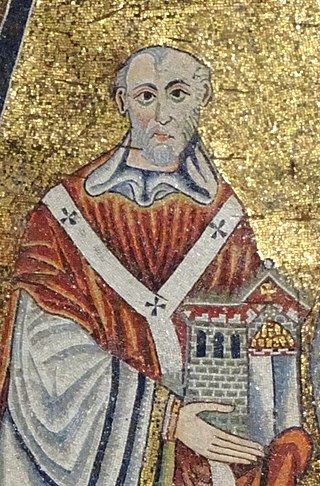
Pope Innocent II, born Gregorio Papareschi, was head of the Catholic Church and ruler of the Papal States from 14 February 1130 to his death in 1143. His election as Pope was controversial, and the first eight years of his reign were marked by a struggle for recognition against the supporters of Anacletus II. He reached an understanding with King Lothair III of Germany, who supported him against Anacletus, and whom he crowned as Holy Roman Emperor. Innocent went on to preside over the Second Council of the Lateran.

Pope Lucius II, born Gherardo Caccianemici dal Orso, was head of the Catholic Church and ruler of the Papal States from 9 March 1144 to his death in 1145. His pontificate was notable for the unrest in Rome associated with the Commune of Rome and its attempts to wrest control of the city from the papacy. He supported Empress Matilda's claim to England in the Anarchy, and had a tense relationship with King Roger II of Sicily.

The Archbishopric of Magdeburg was a Latin Catholic archdiocese (969–1552) and Prince-Archbishopric (1180–1680) of the Holy Roman Empire centered on the city of Magdeburg on the Elbe River.

The Congress of Gniezno was an amicable meeting between the Polish Duke Bolesław I the Brave and Emperor Otto III, which took place at Gniezno in Poland on 11 March 1000. Scholars disagree over the details of the decisions made at the convention, especially whether the ruler of Poland was pledged the king's crown or not.

Łowicz is a town in central Poland with 27,436 inhabitants (2021). It is situated in the Łódź Voivodeship. Together with a nearby station of Bednary, Łowicz is a major rail junction of central Poland, where the line from Warsaw splits into two directions—towards Poznań, and Łódź. Also, the station Łowicz Main is connected through a secondary-importance line with Skierniewice.

Kuyavia, also referred to as Cuyavia, is a historical region in north-central Poland, situated on the left bank of Vistula, as well as east from Noteć River and Lake Gopło. It is divided into three traditional parts: north-western, central, and south-eastern.
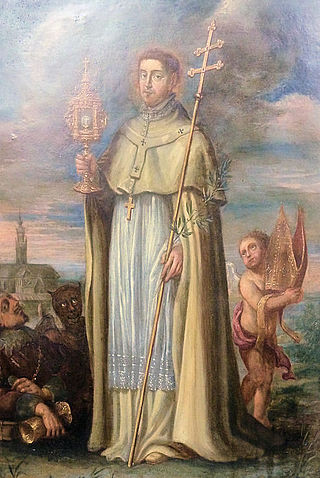
Norbert of Xanten, O. Praem (Gennep-Magdeburg), also known as Norbert Gennep, was Archbishop of Magdeburg, founder of the Premonstratensian order of canons regular, and is venerated as a saint in the Catholic Church. Norbert was canonized by Pope Gregory XIII in the year 1582, and his statue appears above the Piazza colonnade of St. Peter's Square in Rome.
Anacletus II, born Pietro Pierleoni, was an antipope who ruled in opposition to Pope Innocent II from 1130 until his death in 1138. After the death of Pope Honorius II, the college of cardinals was divided over his successor. Unusually, the election was entrusted to eight cardinals, who elected Papareschi. A larger body of cardinals then elected Pierleoni, which led to a major schism in the Roman Catholic Church. Anacletus had the support of most Romans, including the Frangipani family, and Innocent was forced to flee to France. North of the Alps, Innocent gained the crucial support of the major religious orders, in particular Bernard of Clairvaux's Cistercians, the Abbot of Cluny Peter the Venerable; and Norbert of Xanten, the Archbishop of Magdeburg who established the Premonstratensians and held a high rank in the court of the German Emperor Lothar III.
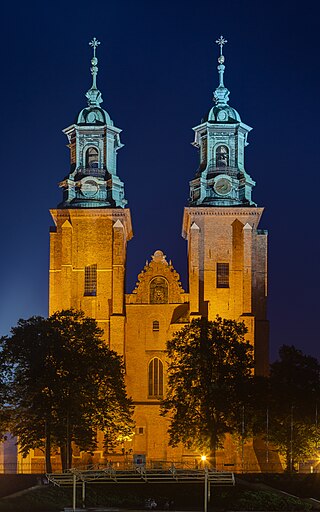
The Archdiocese of Gniezno is the oldest Latin Catholic archdiocese in Poland, located in the city of Gniezno. The ecclesiastical province comprises the suffragan dioceses of Bydgoszcz and Włocławek.

Albero de Montreuil was Archbishop of Trier from 1132 to 1152 and is the subject of the Gesta Alberonis.

The Archdiocese of Wrocław is a Latin Church ecclesiastical territory or archdiocese of the Catholic Church centered in the city of Wrocław in Poland. From its founding as a bishopric in 1000 until 1821, it was under the Archbishopric of Gniezno in Greater Poland. From 1821 to 1930 it was subjected directly to the Apostolic See. Between 1821 and 1972 it was officially known as (Arch)Diocese of Breslau.

The Archdiocese of Berlin is a Latin Church ecclesiastical territory or archdiocese of the Catholic Church in Germany. The archepiscopal see is in Berlin, with the archdiocese's territory extending over Northeast Germany.
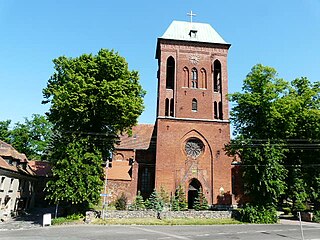
The Bishopric of Cammin was both a former Roman Catholic diocese in the Duchy of Pomerania from 1140 to 1544, and a secular territory of the Holy Roman Empire (Prince-Bishopric) in the Kołobrzeg area from 1248 to 1650.
Adalbert of Pomerania was the first bishop of the 12th century Pomeranian bishopric, with its see in Wolin. He was a monk of the Michaelsberg Abbey, Bamberg and former chaplain to Bolesław III Wrymouth of Poland, whence he knew the Pomeranian language of the temporarily Polish-subjugated West Slavic population, whereas the Joms Vikings and other Germanic inhabitants of the Pomeranian coast understood his old German language.

The 1130 papal election was convoked after the death of Pope Honorius II and resulted in a double election. Part of the cardinals, led by Cardinal-Chancellor Aymeric de la Chatre, elected Gregorio Papareschi as Pope Innocent II, but the rest of them refused to recognize him and elected Cardinal Pietro Pierleoni, who took the name of Anacletus II. Although Anacletus had the support of the majority of the cardinals, the Catholic Church considers Innocent II as the legitimate Pope, and Anacletus II as Antipope.
Gilo of Toucy, also called Gilo of Paris or Gilo of Tusculum, was a French poet and cleric. A priest before he became a monk at Cluny, he was appointed cardinal-bishop of Tusculum sometime between 1121 and 1123. He served as a papal legate on four occasions: to Poland and Hungary around 1124, to Carinthia in 1126, to the Crusader states in 1128 or 1129 and to Aquitaine from 1131 until 1137. He took the side of the Antipope Anacletus II in the papal schism of 1130 and was deposed as cardinal-bishop by the Second Lateran Council in 1139.
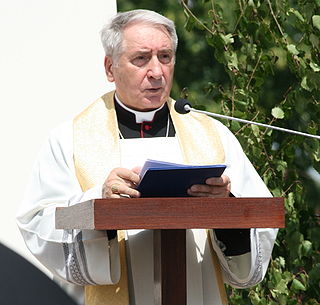
Józef Kowalczyk is a Polish Roman Catholic prelate, canon lawyer and diplomat who, from 1989 to 2010, served as the first apostolic nuncio to Poland since World War II. He later served as archbishop of Gniezno and primate of Poland until his retirement in 2014.

Jakub of Żnin was an early archbishop of Gniezno in Poland. He was archbishop from c. 1124 until 1148.

Henryk Kietlicz was Archbishop of Gniezno from 1199 to 1219 was the main architect of the changes that allowed the Polish church to gain independence from the secular authorities.

The Council of Pisa, was convened by Pope Innocent II in May 1135. An extraordinary number of prelates, archbishops, bishops, monks, and abbots attended the council, including a large number of Italian clergy. The council addressed simony, schismatic clerics, heresy, as well as donations to the Templar Order. Pisa would be the third council Innocent would convene to address issues within the Catholic Church.
















